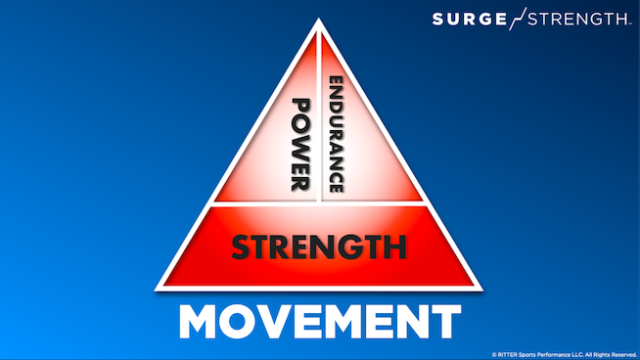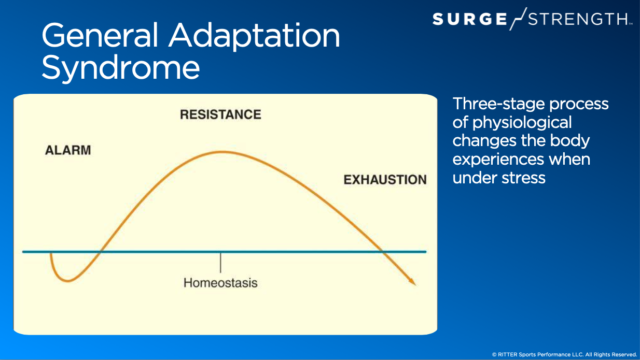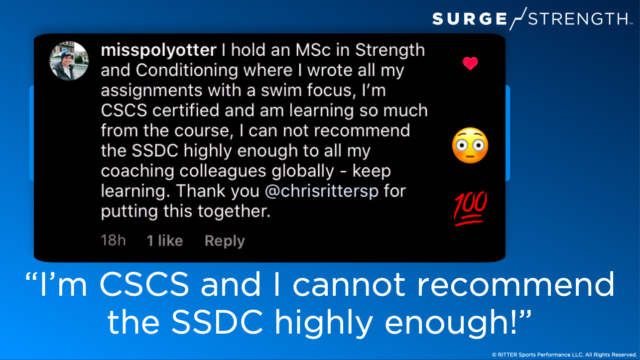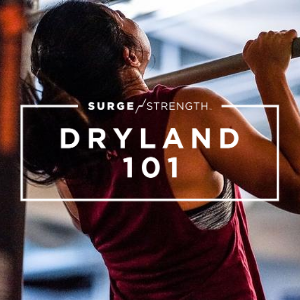Dryland is for all ages and abilities, so it’s important to understand how an athlete’s age affects dryland workouts. However, this doesn’t mean every dryland program is for everyone. Dryland must be scaled to everyone’s individual training age. Training age is determined by how much experience an athlete has with resistance training. It’s important to know that training age does not always correlate to chronological age (how old someone is based off their birthdate). Training age is a key factor in determining how hard, complex, or extensive to make a dryland program.
We have previously talked about each of the various populations you’ll have in dryland training for swimmers. Please reference each of those articles for specific recommendations for each population:
- HOW TO CREATE A DRYLAND WORKOUT FOR YOUNG SWIMMERS (10&UNDERS)
- BEST PRACTICES FOR DRYLAND FOR AGE-GROUP SWIMMERS (11-14YRS)
- HOW TO CREATE THE BEST DRYLAND WORKOUTS FOR HIGH SCHOOL SWIMMERS
- 6 TIPS FOR NAVIGATING DRYLAND WORKOUTS FOR COLLEGE SWIMMERS
- HOW TO CREATE DRYLAND WORKOUTS FOR MASTERS SWIMMERS
- View all previous SURGE Strength Dryland Training Articles
Below, we’ll examine 5 scientific principles that determine an athlete’s training age and ability for more precise dryland programming:
1) Biology
Biology is the first factor to consider in how an athlete’s age affects dryland workouts. An athlete’s biological makeup determines their baseline for dryland training. Biological age refers to an athlete’s stage of maturity and development. Most commonly we think about youth athletes when scaling a dryland program to match biological age. Some athletes will progress through the stages of puberty faster than others. More specifically, at the 11-14 age range, some swimmers are comfortable in their bodies and have the mental and emotional maturity for resistance training. Others feel awkward and aren’t ready to safely handle weights. Consider breaking your youth athletes into dryland groups based on their training age rather than their chronological age. This prevents the more mature athletes from being held back and allows the “younger” athletes to work at a more appropriate pace.
Biological age does not only apply to pubescent athletes. It applies as we age, too. For example, many masters swimmers navigate the changes and barriers associated with aging and life in general. You may have several older swimmers who simply do not have the same capacity as they did when they were younger. Perhaps you have a swimmer is going through menopause. Maybe another younger swimmer just had a baby. Biological life events come into play and should be considered. A one-size-fits-all approach rarely works because our bodies and lives are constantly in different stages.
2) Training Background
A swimmer’s training history contributes heavily to their training age. Think of age in terms of experience rather than a measurement of time. The more experience swimmers have with resistance training or movement in general, the more motor units they will recruit. Motor units are the brain’s way of developing muscle memory through physical activity. Therefore, more motor units make people more athletic. The primary goal of dryland at any point is to is to simply increase motor unit firing. Keep in mind that the saying is true: if you don’t move it, you lose it. Taking long breaks in training (>6 months) requires coaches to regress an individual’s training age in order to re-pave their neuropathways. In other words, it takes time and practice to feel comfortable lifting again after a long hiatus from dryland.

- Motor unit: a motor neuron and all the fibers it innervates.
3) Existing Training Style
This element might not be something that comes to mind at first when considering how an athlete’s age affects dryland workouts, but it’s still important to consider. First, look at where you are in your training to determine where you want to go next. New movement patterns develop by giving the brain as much feedback as possible.
In the SURGE Strength Dryland Certification Curriculum, we recommend incorporating 3 main types of muscle contractions into each dryland session. First, program concentric, or muscle “shortening” contractions. Examples of concentric contractions include starts off the block or jumping explosively into the air. Secondly, teach athletes eccentric, or “lengthening” contractions. These are exercises that require the athletes to absorb force. Think of the ability to land and stick a jump. Lastly, add in isometric contractions. These are trained through holding an exercise. Isometrics are great because they produce muscular endurance. Some examples are planks and wall-sits. Overall, promote a spectrum of ways to hit all three of these muscular contractions. This way, swimmers increase their potential for athleticism. Combined, concentric, eccentric, and isometric exercises build a base of strength, power, and endurance that make swimmers more competitive as they progress in the sport.

- Through concentric, eccentric, and isometric loading, swimmers build a base of strength that ignites their success as a swimmer. Power and endurance build off of a solid strength foundation. Combined, strength, power, and endurance make-up athleticism.
4) Recoverability
It’s important for athletes to recover from each training session. This variable probably changes the most when trying to track how an athlete’s age affects dryland workouts. After all, recovery is the place where actual training adaptations take place. In other words, dryland recovery results in two outcomes: fitness or fatigue. If athletes are not recovering, they will drop below their initial baseline (homeostasis as shown on the graph below) and remain fatigued long-term. The scientific model known as general adaptation syndrome (GAS) shows us how resistance training can result in improved performance (aka fitness) from a dryland session. It also shows us how performance can decline when athletes are pushed to fatigue too far or too often. Unfortunately, when coaches push too much or too fast in dryland, athletes are more susceptible to overtraining and injuries. Therefore, finding the “sweet spot” is incredibly important.

- General Adaption Syndrome: the 3-stage process of physiological changes the body experiences under stress. Ideally coaches should end training when athletes are at the crest of resistance. Often times, coaches push too far and athletes descend below baseline into exhaustion.
Training age also determines the recoverability of an athlete, and therefore, their dryland ability. There are 8 Workout Variables that we use to scale dryland programs. These variables allow coaches to adapt dryland for more work or more recovery. Keep in mind as you implement this concept that people of different biological ages will need different amounts of stimulus that the 8 variables provide.
5) Current Fitness Level
In order to increase dryland ability and your swimmers’ fitness levels, you must work towards progressive overload. Progressive overload is achieved when you gradually increase the stress you place on the body during dryland workouts. Because every athlete starts at a different “training age,” it makes sense that increasing the stimulus in each dryland workout will affect each athlete differently. Keep this in mind. Some athletes will need more stimulus in order to reach progressive overload, while others will only need very slight increases in stress to achieve the same impact. Progressive overload is important but protect your athletes from fatigue by starting with their individual training age in mind. Athletes should be challenged during each dryland session, but it all comes back to finding the “sweet spot” in training.
Swimmers with younger training ages require less “work” to progress in a session. On the other hand, people who have more resistance training experience require a higher threshold of dryland to be significantly challenged. Swimmers who have been out of commission for a while might need to regress their workload in dryland in order to hit their “sweet spot” and avoid overtraining. Similarly speaking, a 20-year-old male should have a different workload than a 10-year-old female. Current fitness level as well as training age should be considered to make sure athletes are being challenged at an appropriate level.

- Progressive Overload: continual increase in workload stimulating muscle growth and strength gain
Conclusions in How an Athlete’s Age Affects Dryland Workouts
The 5 scientific principles mentioned above–biological age, motor unit recruitment, muscle contraction types, general adaption syndrome (GAS), and progressive overload all support creating individualized dryland programs for swimmers. Each of these principles show how different variables intertwine and develop a swimmers training age. Through this process, you can customize your program to adapt best to how an athlete’s age affects dryland workouts. Dryland ability cannot be only determined by age grouping. It’s a disservice to our youth and master’s swimmers alike when we generalize dryland based on age. As swim coaches, we know that age doesn’t always equal ability or potential. We suggest keeping programming simple, yet malleable in order to progress the spectrum of training ages on your team. Next time you write a dryland plan, consider “who” you are coaching before deciding “what” you are programming.
JOIN OTHERS FROM AROUND THE WORLD THAT ARE
BECOMING SURGE STRENGTH DRYLAND CERTIFIED (SSDC)

ENROLL NOW FOR FREE IN THE SURGE STRENGTH ACADEMY
BECOME SURGE STRENGTH DRYLAND CERTIFIED (SSDC)
BUILD BETTER ATHLETES TO GENERATE FASTER SWIMMERS
Courtesy of SwimSwam’s exclusive dryland training partner, SURGE Strength.
SURGE Strength, a strength training brand created by Chris Ritter, CEO of RITTER Sports Performance, aims to build better athletes and faster swimmers through dryland programs, and coaching education.







